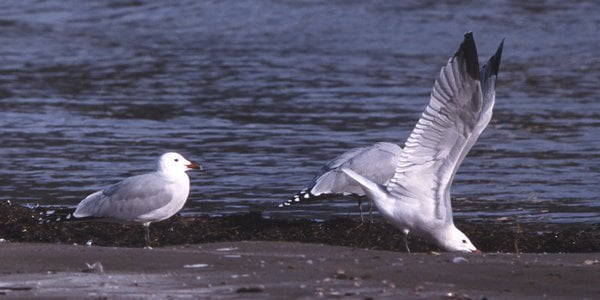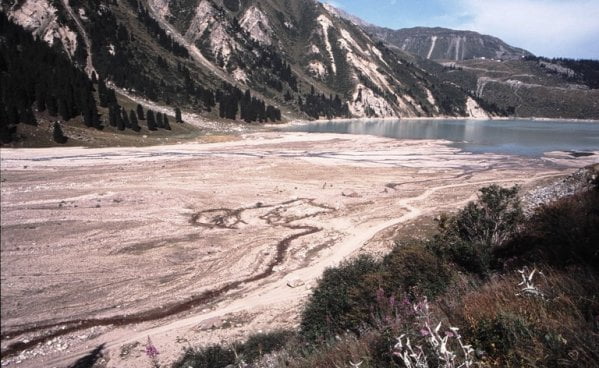To each lifer, there is a story.
Sometimes, the story can be very short, a mere line in the notebook without a memory attached.
Sometimes, the story consists of nothing more than a mental image of having been there and seen that.
And then, there are the lifers whose story is a journey through the birding adventures of two decades.
This is the story of my life Wallcreeper. And of what happened afterwards. And before. Therefore, this post is split into 3 parts, part 1 (this right here) about the “before”, part 2 about the lifer and part 3 about the “afterwards”.
I am not entirely sure when the story of my first ever Wallcreeper starts, but it must have been sometime between 1989 and 1991. Back then I was still a young birder, and there were so many new birds to find and discover on my home turf and during the camper holidays with my parents that the Wallcreeper gap on my list was something I barely noticed.
Frankly, I was far more worried about not having seen a Bearded Vulture yet, an observation that was not to materialize until a trip to Spain in 1995. But I digress.
I had just joined a local bird club that published a yearly report, and had ordered copies of the previous few years’ magazines (more like a pile of photocopied and stapled pages) .
On one of these typical winter evenings – in an arm chair, blanket on lap and hot chocolate at hand (more like a sofa with pizza on the table) – and while I was scanning through these reports in order to come up with a birding plan for the next day, I stumbled upon the Wallcreeper. For many years, one had been a frequent visitor to an old quarry not even 20 miles away, and I had nothing better to go after (you can only look at so many Smew after all…), so a plan was made.
The next day found me at the quarry where I found many nice birds and had a good day overall – but no Wallcreeper. I confess to having been slightly bummed, so I talked to other birders on the phone that evening who had seen the Wallcreeper in previous years.
“It can be hard to spot unless it is feeding. You’ll need patience. It’s a big quarry.”
The next weekend saw patient me again at the quarry and saw patient me again not seeing the Wallcreeper. If my memory serves me right, I returned another one or two times to the quarry and – never finding the bird – finally realized that my search year was the first year the Wallcreeper failed to return. It hasn’t been seen there since.
Contrary to popular belief, this was not a serious matter. As I said, it was just one of those birds for some other time.
In 1992 I started studying Biology in Freiburg right next to the heart of the Black Forest, where I would often go to see neat birds – Nutcracker, Citril Finches, Ring Ouzels, Capercaillies, Three-toed Woodpeckers. The cliffs and quarries of the Black Forest are also the winter haunts of a few Wallcreepers each year. According to other birders’ observations each year. Just not according to my observations – each year.
Again, let me stress that this didn’t upset me – Citril Finches are very fine birds as well.
In 1995, two friends and I went on an epic (yeah, it was epic) 4-week birding trip through Spain where we saw amaaaazing birds, amongst them Little and Great Bustards, Black-bellied and Pin-tailed Sandgrouse, 23 species of raptors including the most amazing bird in the world Bearded Vulture, Black Vultures, Spanish Imperial Eagles, Black-shouldered Kite, Audouin’s Gulls, Dupont’s Larks, all the wheatears & warblers, Azure-winged Magpies, … but no Wallcreeper.
Hey, come on: you can’t have everything and you don’t go to Spain for Wallcreepers, you go there for the birds listed above. So there were no hard feelings – none whatsoever.
Eight out of ten psychiatrists recommend looking at a flock of Audouin’s Gulls to get over a Wallcreeper dip-pression. The rest recommends buying shoes. Two out of ten psychiatrists are known to have taken up their profession as an act of self-therapy.
The spring of 1996 saw me move from Freiburg to Greifswald, at the German Baltic Sea coast – clearly outside the winter reaches of the Wallcreeper. Of course I was a bit sad about not having a chance at wintering Wallcreepers anymore, but I was just fine with the 260+ species of birds I was able to see each year within a 3-mile radius around home. This move however had one significant consequence: I knew I was not going to accidentally stumble upon a Wallcreeper on one of my usual birding days. It was now a matter of having – at best – a few days per year on birding trips abroad, and thus a much more focused approach to seeing a Wallcreeper followed.
Before I continue, I’d like to stress the beauty of the bird. Its pink flashy wings, spotted in black and white, its fine and delicate grey body with its marvellously curved bill make it one of Eurasia’s bird highlights – yes, Dale wasn’t photoshopping around when he wrote this post.
They are truly sublime creatures, as they float like a butterfly along the cliffs of their mountainous habitats, enchanting their observers with the ease of their weightless movements and the brilliance of their impossible colouration.
This is a species a birder can’t despise and brand as a Nemesis, no matter how the bird treats the birder.
Yeah, right. Read on:
The university of Greifswald maintains close academic ties with the universities of Bishkek / Kyrgyzstan and Almaty / Kazakhstan. These ties led to several zoological field trips to the high mountain ranges of these central Asian countries starting in the summer of 1997, and until I graduated and left the university for good in the year 2001, I participated in the trips of 1997, 1998, and 2001. The following table shows the Wallcreeper statistics of the trips:
Year me participating? Wallcreeper?
1997 yes no
1998 yes no
1999 no yes
2000 no yes
2001 yes no
Things were starting to get personal.
The Tien Shan mountains above Almaty. Some will find Wallcreepers at the cliffs. Some, like myself, will have to be satisfied with very good looks at an Ibisbill on the alluvial fan in the foreground.
Others just go there for the scenery.
[This is a badly digitalized 12-year-old slide, so cut me some slack]
Then there was my trip with the biology student’s circle “Jean Baptiste de Lamarck” to Greece in spring 2001 – do I need to mention that I did not see a Wallcreeper?
No?
But I certainly do need to mention that a Wallcreeper was seen on two previous trips of the circle to Greece.
It was getting harder and harder to not start disliking the Wallcreeper, particularly so as I had by now seen the very vast majority of Europe’s birds, with just roughly two handfuls missing, one of them being the creeper of walls. The gap that once was barely noticeable in the late 1980s was starting to itch.
Yet, I maintained my sympathies for the beautiful creature, and I have never, in all this time, named it my nemesis. This was helped by the fact that my fruitless search for Lesser White-fronted Geese was far more depressing, and the fact that I did not undertake any trips to the potential range of the Wallcreeper from the summer of 2001 until January 2010.
How would my luck change in January 2010? This will be covered in part two of my Wallcreeper trilogy.















I had a very similar experience with Northern (Great Grey) Shrike. For years I searched every fence post, every tree top, every TV antennae and saw nothing but Northern Mockingbirds and Blue Jays.
Finally one early November morning, I finally found one. Since that time, they have practically fall out of trees at my feet, so I hope once you get Wallcreeper, you’ll have the same luck!
I have never tried to see a wallcreeper and I have never seen one. Looks like I’m ahead of the game. 🙂
Looking forward to parts 2 and 3!
Oh, that’s funny and interesting. I am also a birder, living in the Heidelberg region, and I like reading this blog (mainly the conservation stuff) 🙂
We “dipped” on a Dipper in the UK!!! We won’t look in obvious places next time!
@Will: you’ll have to wait until part 3. No spoilers!!
@Corey: well, you might want to read part 2. Also, I would have expected you to react to me teasing you about dipping on the Ibisbill. I mean, do you actually read my posts! 😉
@Daniel: you’re in the Heidelberg/Germany region? Have you made contact with other birders? I am not very active here (family, work,…) but please feel free to contact me if you are interested: joroeder AT yahoo DOT com! Also, thanks!
@Clare & Grant: Dipping on a Dipper is unhealthy year-round as they live in really cold mountain streams. Also, they might be crushed if dipped upon, affecting their overall populations. 😉
And the UK, what can I say… if you want to see the goodies of Europe’s birds, visit Germany! 🙂
Which passion. Do you know this documentary?
http://www.wallcreeperthefilm.com/
Beautiful continuation.